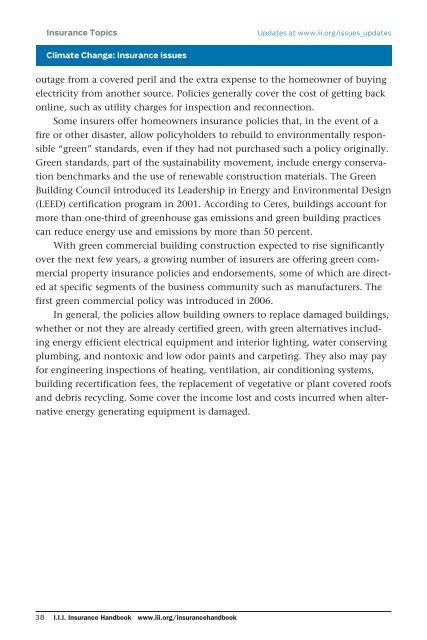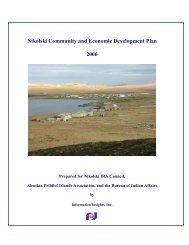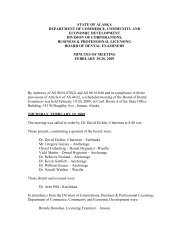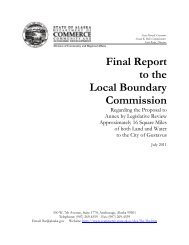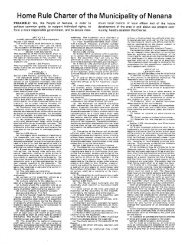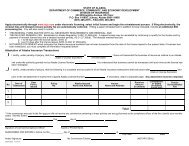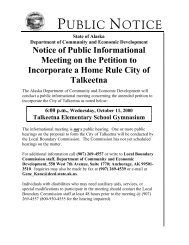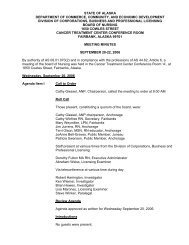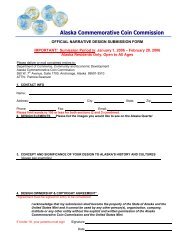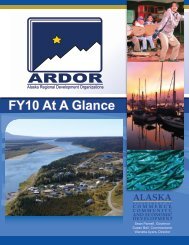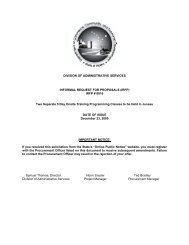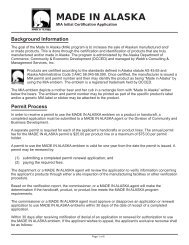Insurance Handbook - Alaska Department of Community and ...
Insurance Handbook - Alaska Department of Community and ...
Insurance Handbook - Alaska Department of Community and ...
You also want an ePaper? Increase the reach of your titles
YUMPU automatically turns print PDFs into web optimized ePapers that Google loves.
<strong>Insurance</strong> Topics Updates at www.iii.org/issues_updates<br />
Climate Change: <strong>Insurance</strong> Issues<br />
outage from a covered peril <strong>and</strong> the extra expense to the homeowner <strong>of</strong> buying<br />
electricity from another source. Policies generally cover the cost <strong>of</strong> getting back<br />
online, such as utility charges for inspection <strong>and</strong> reconnection.<br />
Some insurers <strong>of</strong>fer homeowners insurance policies that, in the event <strong>of</strong> a<br />
fire or other disaster, allow policyholders to rebuild to environmentally responsible<br />
“green” st<strong>and</strong>ards, even if they had not purchased such a policy originally.<br />
Green st<strong>and</strong>ards, part <strong>of</strong> the sustainability movement, include energy conservation<br />
benchmarks <strong>and</strong> the use <strong>of</strong> renewable construction materials. The Green<br />
Building Council introduced its Leadership in Energy <strong>and</strong> Environmental Design<br />
(LEED) certification program in 2001. According to Ceres, buildings account for<br />
more than one-third <strong>of</strong> greenhouse gas emissions <strong>and</strong> green building practices<br />
can reduce energy use <strong>and</strong> emissions by more than 50 percent.<br />
With green commercial building construction expected to rise significantly<br />
over the next few years, a growing number <strong>of</strong> insurers are <strong>of</strong>fering green commercial<br />
property insurance policies <strong>and</strong> endorsements, some <strong>of</strong> which are directed<br />
at specific segments <strong>of</strong> the business community such as manufacturers. The<br />
first green commercial policy was introduced in 2006.<br />
In general, the policies allow building owners to replace damaged buildings,<br />
whether or not they are already certified green, with green alternatives including<br />
energy efficient electrical equipment <strong>and</strong> interior lighting, water conserving<br />
plumbing, <strong>and</strong> nontoxic <strong>and</strong> low odor paints <strong>and</strong> carpeting. They also may pay<br />
for engineering inspections <strong>of</strong> heating, ventilation, air conditioning systems,<br />
building recertification fees, the replacement <strong>of</strong> vegetative or plant covered ro<strong>of</strong>s<br />
<strong>and</strong> debris recycling. Some cover the income lost <strong>and</strong> costs incurred when alternative<br />
energy generating equipment is damaged.<br />
38 I.I.I. <strong>Insurance</strong> <strong>H<strong>and</strong>book</strong> www.iii.org/insuranceh<strong>and</strong>book


